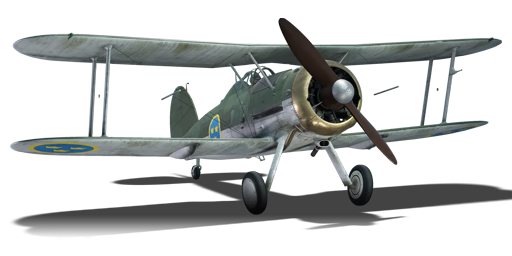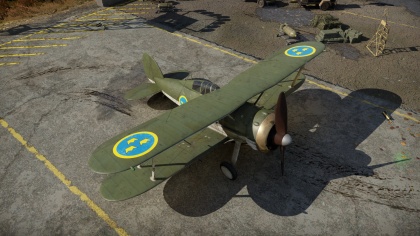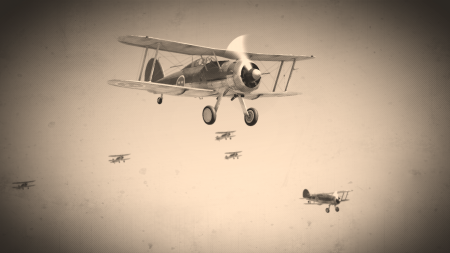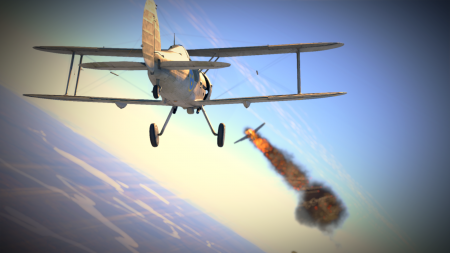Difference between revisions of "J8A"
(→Usage in battles: Fixed formatting) |
(→Pros and cons) (Tag: Visual edit) |
||
| Line 198: | Line 198: | ||
* Can go up to 418 km/h | * Can go up to 418 km/h | ||
| − | * It's four 8 mm machine guns can quickly shred other low tier planes | + | * It's four 8 mm machine guns can quickly shred other low tier planes (And groundbelt can very easily dispatch nearly any tanks at it's BR) |
* 2,000 rounds of ammunition total, can fire continuously about 750 rounds before guns jam | * 2,000 rounds of ammunition total, can fire continuously about 750 rounds before guns jam | ||
* Very high max altitude for its rank | * Very high max altitude for its rank | ||
Revision as of 00:49, 31 May 2020
Contents
| This page is about the Swedish fighter J8A. For other versions, see Gladiator (Family). |
Description
The J8A is a rank I Swedish fighter
with a battle rating of 1.0 (AB/RB/SB). It was introduced in Update 1.93 "Shark Attack" but was unavailable to be played in any game mode, however, it could be flown in test-flight and with the mission editor against NPC aircraft. The aircraft was fully implemented in Update 1.95 "Northern Wind".
The J8A or the original Gloster Gladiator Mk II was developed in an awkward time, in that it was an advancement in bi-plane technology over what was already in production, however, its time was almost up even before it rolled out the door as state-of-the-art monoplanes were beginning to take to the skies and outperform even the most advanced biplanes. Though a long future looked grim for the Gladiator, nevertheless it went into production and found a place in the Air Forces not only for the British but other nations such as the Swedish.
Initially a private venture by Gloster, the SS.37 started by modifying an existing prototype, the Gloster Gauntlet and outfit it with a Bristol Mercury M.E.30 radial engine and streamline the existing structure and wings to increase aerodynamic efficiency. By the time trials started, the plane was outfitted with a Mercury IV engine and then retooled for the Mercury VIS engine. Later adjustments outfitted the aircraft with a Mercury IX engine and a two-blade wooden fixed-pitch propeller, though some later models switched to a three-bladed metal pitch-adjustable propeller.
The Gladiator was the last British biplane to be produced, but it was the first one to feature a fully enclosed cockpit and though it entered service with the British, it almost immediately left the service being replaced by newer-generation fighters such as the Hawker Hurricane and Supermarine Spitfire. While the British no longer found use with the biplanes, other nations felt they would be a fine addition and countries such as Sweden and 12 other countries nabbed up 216 of the remaining Gladiators. Those picked up by Sweden were redesignated J8A (Jaktplan = fighter airplane).
General info
Flight performance
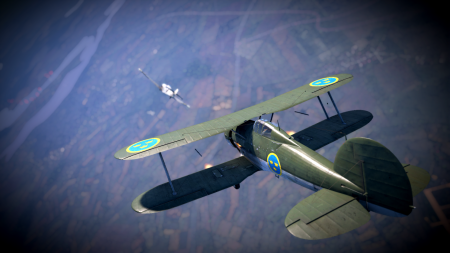
The J8A is an average biplane in terms of manoeuvrability, however, it is very stiff to the controls when attempting to roll the aircraft. Though an excellent flyer at lower altitudes and at lower speeds, keeping its speed up will increase its effectiveness when engaging in turn battles with other aircraft. The Bristol Mercury-IX engine allows this aircraft to reach top speeds of over 400 km/h (~250 mph) and can be a contender with other biplanes, however it will start to struggle against early monoplanes such as the Heinkel He 112, Messerschmitt Bf 109A, Polykarpov I-16 and the Brewster F2A fighters. Though not as fast nor does it have the armament these do, it does have a turning advantage they do not and can sometimes make a quick turn around or tail-chase a faster fighter long enough to put guns on target and eliminate an enemy.
The J8A has a very low stall speed and with the throttle reduced to around 55%, this fighter can maintain level flight at a speed of about 80 km/h (50 mph) without nosing over. The vertical stabilizer is rather large for an aircraft of this type which lends itself to being an excellent aircraft for performing wing-over and hammerhead manoeuvres, especially when luring newer and unsuspecting enemy pilots into a rope-a-dope manoeuvre allowing for the J8A to immediately change direction and pursue the tailing enemy fighter which may have themselves stalled out and set themselves up to be the perfect target for an inbound J8A.
| Characteristics | |||||||
|---|---|---|---|---|---|---|---|
| Stock | |||||||
| Max Speed (km/h at 4,420 m) |
Max altitude (meters) |
Turn time (seconds) |
Rate of climb (meters/second) |
Take-off run (meters) | |||
| AB | RB | AB | RB | AB | RB | ||
| 402 | 385 | 10211 | 16.7 | 17.3 | 13.4 | 13.4 | 232 |
| Upgraded | |||||||
| Max Speed (km/h at 4,420 m) |
Max altitude (meters) |
Turn time (seconds) |
Rate of climb (meters/second) |
Take-off run (meters) | |||
| AB | RB | AB | RB | AB | RB | ||
| 429 | 414 | 10211 | 15.3 | 16.0 | 18.2 | 15.7 | 232 |
Details
| Features | ||||
|---|---|---|---|---|
| Combat flaps | Take-off flaps | Landing flaps | Air brakes | Arrestor gear |
| X | ✓ | ✓ | X | X |
| Limits | ||||||
|---|---|---|---|---|---|---|
| Wings (km/h) | Gear (km/h) | Flaps (km/h) | Max Static G | |||
| Combat | Take-off | Landing | + | - | ||
| 600 | 560 | N/A | 520 | 320 | ~11 | ~5 |
| Optimal velocities | |||
|---|---|---|---|
| Ailerons (km/h) |
Rudder (km/h) |
Elevators (km/h) |
Radiator (km/h) |
| < 240 | < 200 | < 330 | > 190 |
| Compressor (RB/SB) | ||
|---|---|---|
| Setting 1 | ||
| Optimal altitude | 100% Engine power | WEP Engine power |
| 4,115 m | 810 hp | 826 hp |
Survivability and armour
Like many aircraft just prior to the break out of World War II, the J8A was not outfitted with any armour plating. The J8A relied on its engine to get the aircraft where it needed to go and helped the aircraft get into a position where the guns should shoot down an enemy, any attempts to install armour plating would have only slowed down the already relatively slow biplane which would not have been worth the trade-off.
To maintain the centre of balance for this fighter, the pilot, fuel tank and engine take up the fuselage from the middle to the front, any attacks on this aircraft in this zone risk hitting a critical component, ending the J8A's fight in the battle earlier than expected. Though a closed cockpit may offer the pilot protection from glancing shots, it will not do much for head-on or side attacks.
Armaments
Offensive armament
The J8A is armed with:
- 2 x 8 mm Ksp m/22 machine guns, side-mounted (600 rpg = 1,200 total)
- 2 x 8 mm Ksp m/22 machine guns, wing-mounted (400 rpg = 800 total)
The Swedish Air Forces decided to not outfit their J8A fighters with the standard .303 machine guns the British typically used, instead they opted to install four 8 mm Ksp m/22 machine guns, two mounted on each side of the pilot within arm's reach and the other two were mounted one under each side of the lower wing. It is important for pilots of this aircraft to determine at what distance they typically engage enemy aircraft at as convergence of the machine guns is a necessity to manage to effectively put as many bullets as possible into the enemy fighter. Typically in biplanes, a closer convergence setting of 100 to 250 m is best for close-in fighting, typically as one gets farther out from there, bullets lose some of their punch.
Many ace pilots from all sides of the war stated that when the enemy filled the windscreen, there was no way you could not hit, thereby guaranteeing a hit and conserving ammunition. The J8A does not have the machine-gun speed of those found on some Russian biplanes as it is necessary to synchronize the firing of the guns in the fuselage to fire through the propeller arc. With 2,000 rounds of ammunition distributed between all four machine guns, it is recommended to fire in short bursts, mainly to prevent overheating and jamming of the machine guns. Typically you can continuously fire about 750 rounds of ammunition before the guns jam up and require a cool down before they can be used again.
When possible, change out the default ammunition belts for either tracer belts which are very effective against other biplanes, especially those which have fabric coverings and non-self sealing fuel tanks as tracer rounds have a good chance of setting planes on fire which can rarely put the flames out. Air belts are another good choice due to the explosive filler in the round which helps to damage or disable aircraft faster than regular bullets. For those pilots who like to sneak into a fight and catch enemy aircraft unaware, stealth belts are the way to go as there are no tracer rounds to give away your position. The enemy pilots tend to realize where the stealth bullets are coming from only too late as their aircraft is coming apart and falling to the ground.
Usage in battles
On early maps which tend to favour biplanes and some early monoplanes, the J8A pilot has the option to decide which type of target they will go after and arm up the ammunition to do so. The J8A is a multirole aircraft which can pursue either air-to-air combat, ground attack or both. The J8A is a very effective turn fighter and can hold its own against many early biplanes, but due to its speed, it has the option to turn fight or attempt early Boom & Zoom runs. If flying at an altitude above the enemy aircraft, the J8A can selectively choose targets, swoop down on them and either zoom back up to altitude or zoom away out of range of slower aircraft before turning around.
One of the advantages of this aircraft's low-speed capabilities is its very low stall speed, which lends itself to be handy when strafing ground targets. Lightly armoured targets such as anti-aircraft artillery, light trucks and some light tanks can be in reach with the J8A. When swooping in at a lower speed and attacking ground targets, after a pass, fly up in a shallow climb and perform a wing-over to immediately face the direction you just came in and begin to target up enemy vehicles and repeat. Fortified pill-boxes, medium and heavy tanks should be avoided as they will be relatively impervious to the 8 mm machine gunfire.
J8A fighters work great in teams of two or three. Fighters can rotate being "bait" for enemy aircraft, attempting to take an enemy for a tail and while the enemy if focusing on their target, one or both of your teammates then zip in and take out the enemy target and if you happen to catch them when they are close to stall speed, the easier it will be to eliminate them from the match.
Manual Engine Control
| MEC elements | ||||||
|---|---|---|---|---|---|---|
| Mixer | Pitch | Radiator | Supercharger | Turbocharger | ||
| Oil | Water | Type | ||||
| Controllable | Not controllable Not auto controlled |
Not controllable Not auto controlled |
Not controllable Not auto controlled |
Separate | Not controllable 1 gear |
Not controllable |
Modules
| Tier | Flight performance | Survivability | Weaponry | |
|---|---|---|---|---|
| I | Fuselage repair | Radiator | Offensive 8 mm | |
| II | Compressor | Airframe | ||
| III | Wings repair | Engine | New 8 mm MGs | |
| IV | Engine injection | Cover | ||
Pros and cons
Pros:
- Can go up to 418 km/h
- It's four 8 mm machine guns can quickly shred other low tier planes (And groundbelt can very easily dispatch nearly any tanks at it's BR)
- 2,000 rounds of ammunition total, can fire continuously about 750 rounds before guns jam
- Very high max altitude for its rank
- Fixed-pitch propeller reduces the need for manual engine control tweaking
- Fantastic rudder control for stall manoeuvres
- Very low stall speed
Cons:
- Climb rate is slower than most other planes that rival it
- Poor roll rate
- Higher than average required takeoff length for biplanes
- No armour protection
- During simulator battles, much of the front view is obscured by the upper wing and canopy framing
- No option for bombs or rockets, strict aerial or ground attack with 8 mm machine guns only
History
In 1936, a new defence resolution was made by the Swedish defence ministry to organise one new fighter wing and four new bomber wings in light of rising tensions in Europe. The new fighter wing was intended to provide an aerial defence to the Stockholm region and would consist of three squadrons. After a selection process, the Gloster Gladiator was found to be the aircraft most suited to requirements, and an order was made for 55 aircraft, which were to be locally fitted with engines and armament.
The first Gloster Gladiator was delivered to the Swedish Air Force on April 15th 1937 and locally designated as the 'Jaktplan 8' (J8). While the first few Swedish Gladiators were fitted with the Fairey three-bladed propeller, the decision was taken to switch back to the earlier fixed-pitch two-bladed wooden propeller. The first 37 aircraft were built to Gladiator Mk.I standard with a 645 hp NOHAB-built Bristol Mercury VIS2; the last batch of 18 aircraft were built to Gladiator Mk.II standard with an 840 hp NOHAB-built Bristol Mercury VIII. The former batch thus became known as the J8, while the latter batch was known as the J8A. Both types were armed with the Ksp m/36, which was a license-built version of the Browning M1917 chambered for 8x63mm ammunition. Deliveries of the Swedish Gloster Gladiator concluded on July 16th 1939, but two aircraft were already lost in service before deliveries were finalised. The Gladiators were initially allocated to F1 Västmanland in 1937 before a new wing was formed. This wing, F8, was transferred to Barkarby, north of Stockholm, in October of 1938, becoming F8 Barkarby.
Initial impressions of the Gloster Gladiator were mixed: the type was brand-new (having first flown in 1934 and having entered RAF service in February of 1937), but already conceptually outdated in comparison with types such as the German Bf 109, British Hawker Hurricane and the American P-35. As a result, more modern types were urgently sourced.
International events led to the Swedish J8 to have their combat debut in 1939 - albeit not under Swedish colours. Following the invasion of Finland by the Soviet Union on November 30th 1939, numerous countries offered military support to Finland, including neighbouring Sweden which went as far to form a volunteer squadron - Flygflottilj 19 - which would enter combat under Finnish colours. The F19 Wing consisted of 12 J8A Gloster Gladiators capable of carrying 8 light bombs and 4 B4 Hawker Harts light bombers, supported by a Junkers F13, a Raab-Katzenstein RB-26 and a Waco ZQC-6 liaison aircraft, and was manned entirely by Swedish volunteers. After intense negotiations and preparations during December 1939 and early January 1940, the F19 Wing entered combat on January 12th 1940 with a raid on Soviet troop concentrations and air bases near Märkäjärvi, Salmijärvi and Salla. While the Hawker Hart bombers fared rather badly against enemy opposition (2 collided and 1 was shot down on this first raid, with 1 crew member killed, 2 taken PoW and 3 managing to ski back to their bases), the Gloster Gladiators went on to do rather better during their deployment. Over the course of two months, Swedish pilots claimed 10 kills; other than the 3 Harts lost on the first raid, the unit lost 3 Gladiators of which 2 were lost in accidents (one in a landing accident, pilot unhurt, and one due to structural failure, pilot killed), and 1 was shot down by Soviet airmen on January 23rd 1940 (pilot KIA). Following the cease-fire of March 13th 1940, the F19 Wing returned to Sweden and was disbanded.
In 1940, F8 Barkarby was re-equipped with the J9 (Seversky EP-1), with the J8s transferred to the F9 Säve wing which was tasked with protecting Gothenborg. The J8's stint with F9 was short, being replaced by the J11 (Fiat CR.42), after which they were used to equip the F10 Ängelholm Wing tasked with protecting Malmö. When the F10 Wing, in turn, was re-equipped with the J20 (Reggiane Re.2000), the J8's role as a frontline fighter in Swedish Air Force service was considered over, and the aircraft were distributed among other wings as advanced trainers, reserves and base hacks. During the latter part of their career in the Swedish Air Force, J8s were used piecemeal by the F8, F9, F10, F13, F16 and F20 wings. About 20 aircraft remained in service at the end of the Second World War, at which point they were progressively withdrawn from service as they were considered as being at the end of their service life. The last three Swedish J8 Gladiators were withdrawn from service on February 10th 1947.
Media
Excellent additions to the article would be video guides, screenshots from the game, and photos.
See also
- Other variants in-game
- Aircraft of comparable role, configuration and era
External links
- [Wikipedia] Gloster Gladiator
- [IPMS Stockholm] Gloster Gladiator in Detail - Gladiators in Sweden
- [Håkans aviation page] J8 Gloster Gladiator in the Swedish Air Force
- [Jari Juvonen's page] Gloster Gladiator Mk II ( J8A )
| Gloster Aircraft Company, Limited | |
|---|---|
| Fighters | Gladiator Mk II · Sea Gladiator Mk I · Gladiator Mk IIF · Gladiator Mk IIS · Tuck's Gladiator Mk II |
| Jet Fighters | Meteor F Mk 3 · Sea Meteor F Mk 3 · Meteor F Mk 4 G.41F · Meteor F Mk 4 G.41G · Meteor F Mk 8 G.41K · Meteor F Mk.8 Reaper |
| Javelin F.(A.W.) Mk.9 | |
| Export | J8A · Iacobi's J8A · ␗Gladiator Mk I · ▄Gladiator Mk I |
| ▄Meteor F Mk.8 · Meteor F.8 · Meteor NF.13 | |
| See Also | Fokker |
| Sweden fighters | |
|---|---|
| ASJA | J6B |
| Saab | J21A-1 · J21A-2 · A21A-3 |
| FFVS | J22-A · J22-B |
| Foreign Import | J8A · Iacobi's J8A · J9 Early · J11 · J20 · J26 David · J26 |
| Finland | |
| VL | Mörkö-Morane · VL Myrsky II · VL Pyörremyrsky |
| (NL) Fokker | ▄Fokker D.XXI-3 · ▄Fokker D.XXI |
| (DE) Messerschmitt | ▄Bf 109 G-2 · ▄Bf 109 G-6 Erla · ▄Bf 109 G-6 |
| Other | ▄B-239 · ▄Hurricane Mk I/L |


